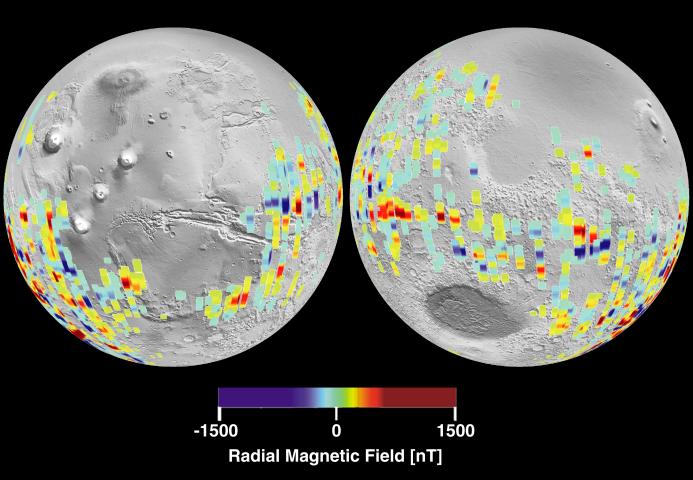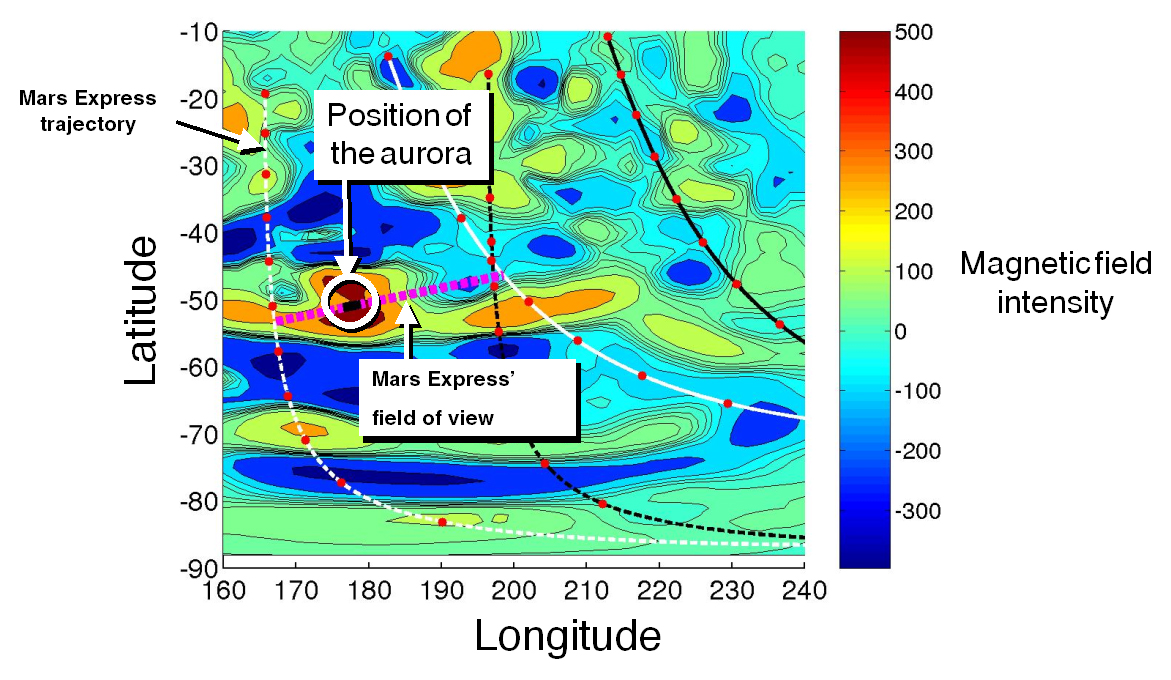If you’ve been lucky enough to ever see the aurorae (or Northern Lights) on Earth, I’m sure you’ll remember it as a spectacular sight. Fortunately, this phenomenon is not unique to the Earth: Venus, Jupiter, Saturn and Mars all have their own unique auroae, and none of them would appear to a Martian or Venusian like those of our own planet.The SPICAM instrument aboard Mars Express first observed an auroral emission event in 2004, and has since been training its UV eyes on the planet, observing a total of nine events since.
Aurorae are created by the interaction of electrically charged particles with the atmosphere of a planet. The solar wind is made up of these charged particles, and when they pass near an orbiting planet, the magnetic field channels them along its field lines (in the case of the Earth, this occurs near the poles). When the interaction occurs, light is emitted, whether it be in the infrared, visible or ultraviolet. On Earth – which has a magnetic field created by a dynamo inside of the planet – the light is visible. Saturn’s recently discovered aurorae can emit light in the infrared, and Jupiter’s aurorae are much more complicated, emitting light in the UV.
Mars doesn’t have it’s own magnetic field, though. Large stores of magnetic rocks in the crust of Mars are scattered throughout the entire planet, and the aurorae correlate with the concentrations of these rock.

SPICAM has observed nine aurorae, all near highly magnetic locations mapped by the Mars Global Surveyor Electron Reflectometer. Though there is a strong correlation between the aurorae and magnetic locations, this isn’t absolute proof that the magnetic fields in these regions are the only cause of the aurorae, but it is rather likely.
The large magnetic field structure of the Earth accelerates the charged particles, which slam into the atmosphere and spark auroral events. The dispersed nature of the magnetic fields on Mars wouldn’t do this, which leaves scientists unsure as to how exactly the aurorae are created.
“It may be that magnetic fields on Mars connect with the solar wind, providing a road for the electrons to travel along,” said Francois Leblanc, from the Service d’Aéronomie, lead author of a paper on the aurorae observed so far, titled “Observations of aurorae by SPICAM ultraviolet spectrograph on board Mars Express: Simultaneous ASPERA-3 and MARSIS measurements” which appeared in the August 2008 Journal of Geophysical research.
The elements that create the colors we see here on Earth – molecular and atomic oxygen and molecular nitrogen – are not very abundant in the thin atmosphere of Mars. SPICAM can only see in the ultraviolet, so is not equipped to detect whether the aurorae would be visible to the human eye. So will future Martian colonists looking out of their glass-domed cities have spectacular light shows every time the Sun acts up?
“We’re not sure whether the aurorae will be bright enough to be observed at visible wavelengths,” said Leblanc.
Source: ESA


Well considering the role our magnetic field plays in our continued existence, this is some interesting news at the least.
I wonder, if you could land within an area affected by this magnetic field, would it help to give the astronauts additional protection from radiation while on the Martian ground?
We could so aim solar reflectors and dishes at the planet to turn it into lava and then make it geologically active. Then it could develop a magnetic field like ours… How many years could such a process take, hehe.